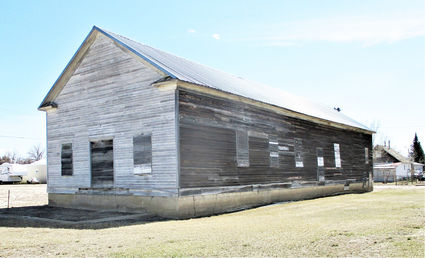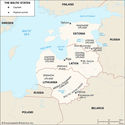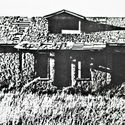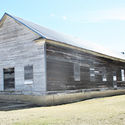South of the Border: Estonians - Builders from the Baltics in Liberty County
May 13, 2020

This photo shows one of two Estonian sod huts built northwest of Chester in the early 1900's. The 18' by 45" structure had five rooms and a loft. The bricks used to construct the house were made on site and weighed about 50 pounds each. The house had a wood floor and a shingled roof. The two houses survived almost a century before succumbing to the elements a few years ago.
Columnist's note: My rancher friend Bob Thompson asked if I knew about the pioneer-era "sod houses" northwest of Chester. He explained a couple of sod houses were built by Estonians who had a sizeable settlement northwest of Chester in the early 1900's and that several descendants of the original homesteaders still farm in the area. Thinking that might be a topic for a column, I discovered the influence of these builders from the Baltics reached beyond their original settlement just north of Tiber (an old post office site five miles west of Chester on Highway 2). Here's some of what I learned about the Estonians in Liberty County.
The first sizeable wave of Estonians immigrants came to the U.S. in the early 1900's
The 1905 Russian revolution spread to Estonia where the leaders demanded autonomy for the Baltic state. The Russians crushed the movement and many Estonians fled to other countries. Most of the Estonians came to America's urban areas, particularly the northeast. A few made agricultural settlements in the Midwest, namely in South Dakota, North Dakota and Chester, Montana. About 40 families from Estonia settled a few miles north of Tiber in the early 1900's.
A series of agricultural calamities, including grasshoppers, cut worms and drought, seriously challenged agriculture in this part of Montana during the early 1920's. By the mid-1920's many Estonians left the area to pursue other interests. A few families stayed (one said, "We were too broke to even move.") and several descendants of that group are still in the area.
Estonians' sod houses were built with homemade bricks rather than cut sod
Several homesteaders' accounts describe two sod houses likely built before most of the "40 families" arrived around 1909-1919. Jake Walkman came to Montana with his parents in 1911 and remembers helping his father build a sod house for another family. His father had built similar houses in Estonia. Lizzie Laas wrote that the sod houses were already in place when she arrived in 1916. The sod houses were some of the earliest permanent buildings in the settlement.
Walkman described how a pit was dug near the building site for a house. Dirt, straw or other binding material and water were combined in the pit and mixed by barefooted helpers stomping the mixture to the right consistency. That mixture was poured in to 24" by 8" by 8" forms. The bricks cured from the sun. The bricks weighed about 50 pounds and as higher levels were added the workers rigged horses and planks to lift the bricks in to place. A shingled roof was added as well as wooden floors, internal walls and wood-framed doors and windows.
Lizzie Laas' granddaughter recalled a two storied sod house "with living quarters atop a barn like structure with the animals below." The houses were described as "warm in the winter and cool in the summer." Walkman said "whitewashed houses looked like stone." Both houses survived for many years. The last of the two was severely damaged during a wind storm a few years ago and collapsed.
The Estonian Farmers' Hall became the community hall for Chester
The "Chester Democrat" newspaper ran a story in May, 1917 about the construction of a community hall in the "Finn" settlement northwest of town (Spoken Estonian sounded like Finnish and many locals referred to the area as a Finn settlement). The Estonian community constructed a 33' by 36' building. The hall completion was celebrated with a huge dance in July, 1917. The hall was used for social gatherings as well as a language school for the younger children before they moved on to regular school.
Following the departure of many families after lean farming, in 1926 the Chester Camp of the Modern Woodmen of the World bought the hall and moved it in to a "suitable site in town." (the old hall is one block south of Highway 2 at the corner of 1st Street W and West Adams). The Woodmen added a 24 foot extension resulting in "the largest open floor space in Chester."
Looking for space to host "outside school activities" the school system leased the hall. Variously called the Community Hall, Woodman Hall or Finn Hall, the building hosted a variety of events from political rallies to dances and traveling shows. The year the hall opened a fire from an overheated stove gutted the interior but repairs were quickly made.
Many Chester folks recall first roller skating at the hall in 1938. In 1944 plans were completed for a Youth Center to provide regular recreation for senior and junior high students as well as "older young folks." But the hall was plagued with maintenance issues needed costly improvements. Now owned by the school board, plans were made to sell the building at auction. At the first auction in 1949 there were no bidders.
In 1951 Clifford Leighton bought the Community Hall for $7,000-that was the only bid. The building was used for the next 30+ years as storage for Chester Implement (the local John Deere dealer). An occasional community event was still held there, like the Jaycee's second annual Haunted House. Jennings Mattson bought the old hall and his son, Mike, still owns the building. It's just six years shy of surviving for a century.

Built in 1917 this building was moved from a rural site north of Tiber to Chester in 1927. The Estonian Farmers' Hall was used for social gatherings and a language school. After agriculture faltered in the early 1920's the Woodmen of the World chapter in Chester bought the building and it became a community hall for the town. Nearly 100 years old, the building now is used for storage.
After World War II there was a second wave of immigrants fleeing Estonia to avoid Russian rule, some of whom came to the U.S. The U.S. Census Bureau's Community Survey identified just over 28,000 Americans of full or partial Estonian descent. There has never been a huge Estonian presence in the U.S. In Liberty County the builders from the Baltics left evidence of their time here, but their numbers, just like at the national level, remained small.





